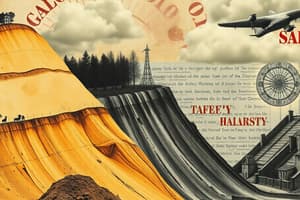Podcast
Questions and Answers
Which of the following is NOT considered a warning sign of an impending sinkhole?
Which of the following is NOT considered a warning sign of an impending sinkhole?
- New small ponds that appear after rain
- Cracks in the ground
- Tilting trees or fence posts
- Creaking sounds in trees (correct)
How can changes in water flow indicate potential geological issues?
How can changes in water flow indicate potential geological issues?
- Water flow changes do not correlate with landslides.
- Increased water pressure can create a sinkhole.
- Withdrawal of water is irrelevant to terrain stability.
- Wet ground may appear on previously dry terrain. (correct)
What does a debris flow most commonly consist of?
What does a debris flow most commonly consist of?
- Water alone with no other materials
- Trees, mud, rock, and vegetation (correct)
- Only large boulders and minimal vegetation
- Dry soil and non-mobile materials
Which symptom might indicate soil disturbance or instability unrelated to water?
Which symptom might indicate soil disturbance or instability unrelated to water?
Which of the following symptoms suggests an unusual presence of wildlife that could indicate problems beneath the surface?
Which of the following symptoms suggests an unusual presence of wildlife that could indicate problems beneath the surface?
Which of the following is NOT a natural cause of landslides?
Which of the following is NOT a natural cause of landslides?
How do mining activities contribute to landslides?
How do mining activities contribute to landslides?
What role does climate play in the stability of soil in sloped areas?
What role does climate play in the stability of soil in sloped areas?
What is an indicator of an impending landslide?
What is an indicator of an impending landslide?
Which sign indicates a potential reactivation of an existing landslide?
Which sign indicates a potential reactivation of an existing landslide?
What could cause tension cracks to form in higher elevated ground?
What could cause tension cracks to form in higher elevated ground?
What do J-curved trees indicate about ground stability?
What do J-curved trees indicate about ground stability?
Which of the following processes can lead to erosion as a cause of landslides?
Which of the following processes can lead to erosion as a cause of landslides?
Flashcards
Debris Flow
Debris Flow
A type of landslide where water mixes with mud, rock, and debris, creating a fast-moving and destructive flow.
Sinkhole
Sinkhole
A sudden drop in the ground level. This can occur when underground rocks dissolve, creating a void.
Changes in Water Flow
Changes in Water Flow
Changes in the water flow, such as new springs or wet areas appearing, or unexpected water withdrawal, can indicate instability in the ground.
Cracking and Creaking
Cracking and Creaking
Signup and view all the flashcards
Tilting Trees or Fences
Tilting Trees or Fences
Signup and view all the flashcards
Climate Change & Landslides
Climate Change & Landslides
Signup and view all the flashcards
Earthquakes and Landslides
Earthquakes and Landslides
Signup and view all the flashcards
Weathering and Landslides
Weathering and Landslides
Signup and view all the flashcards
Erosion and Landslides
Erosion and Landslides
Signup and view all the flashcards
Mining & Landslides
Mining & Landslides
Signup and view all the flashcards
Clear Cutting & Landslides
Clear Cutting & Landslides
Signup and view all the flashcards
Tension Cracks: Landslide Warning
Tension Cracks: Landslide Warning
Signup and view all the flashcards
Bent Trees: Landslide Indicator
Bent Trees: Landslide Indicator
Signup and view all the flashcards
Study Notes
Natural Causes of Landslides
- Climate: Long-term climate changes significantly impact soil stability. Reduced precipitation can lead to landslides, especially when slopes are saturated with water. Mechanical root support is crucial; its absence can lead to soil runoff.
- Earthquakes: Seismic activity contributes to landslides globally. Tectonic plate movements displace soil covering them, leading to landslides.
- Weathering: Rock deterioration, due to natural processes and chemical action from water, air, plants, and bacteria, can weaken slopes, making them susceptible to landslides. Weak rocks slip easily.
- Erosion: Factors like running water, streams, rivers, wind, currents, ice, and waves can erode slope support, making landslides more likely.
- Volcanic Eruptions: Wet conditions during eruptions initiate landslides. Stratovolcanoes are a common cause of volcanic landslides. Volcanic gases can dissolve in groundwater, creating acidic hydrothermal systems that weaken rocks.
- Forest Fires: Wildfires remove protective vegetation, increasing runoff, erosion, and debris flow. Burrowing insects contribute by aerating the soil, which destabilizes it, during wildfire.
Forest Fires
- Wildfires destroy vegetation, reducing soil stability. This increases runoff and erosion.
- Burrowing insects aerate soil, which reduces stability and contributes to landslides during wildfire.
Gravity
- Steeper slopes coupled with gravity can trigger landslides.
- Debris from slopes travels further down steeper slopes
Human Causes of Landslides
- Mining: Blasting techniques greatly contribute to landslides.
Sinkholes
- Sinkholes form when sedimentary rocks dissolve, creating voids. These voids can contain water or air.
- Sinkholes can manifest as holes or depressions.
- Pumped groundwater or broken pipes can contribute to internal erosion, leading to sinkholes.
Signs of Impending Landslides
- Earlier Landslides: Frequent occurrences within a section suggest landslide risk in that area.
- Tension Cracks: These stress-induced cracks, especially above existing landslides, indicate future risk. Cracks above flat terrain indicate fault movement, not landslide.
- Moving Objects: Non-living objects moving or deforming not by human activity indicate landslide development.
- Tree Bending and Curved Trees and Patches: Indicate slope instability and suggest impending landslides. A patch of angled forest on a slope is also a warning sign.
Water and Landslides
- Changes in water flow—like the appearance of springs, seeps, or wet areas in dry regions—can indicate increasing pressure within sloping terrain and increased risk of landslides.
- Groundwater alteration and alteration of drainage systems contribute to landslide risk. Water causes the alteration of pressure within slopes.
Studying That Suits You
Use AI to generate personalized quizzes and flashcards to suit your learning preferences.




